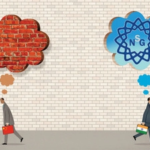Hilary Clinton the Secretary of state and also Presidential candidate of the Democrats once said, ” Part of diplomacy is to open different definitions of self-interest ” which essentially means is that diplomacy cannot be permanent and needs to change and transform in various ways and manner fulfilling the basic objectives.
If the purpose of Chinese government is to see that China emerges as a strong nation, that comes true to the aspirations of its people than it needs to adopt and utilise multiple channels of diplomacy and tools rather than having fixation of old enemies and friends concept. One never knows the outcome of certain events unless they are tried and especially in international relations such experiments can pay handsomely ( case in point is the mutually beneficial relationship of United States with Germany and Japan after world war II).
No other country than United States has demonstrated better, the art of diplomacy in practice, perhaps due to its excellent school and institutes of management ( Harvard, Wharton, etc. ) .
A recent example was seen when very aptly when the US opened diplomatic relations with Cuba warmed after a time line spanning more than 50 years (http://www.cfr.org/cuba/us-cuba-relations/p11113). Similar attempts are seen wrt Venezuela too. United States is perhaps the only country in the world which keeps its diplomatic efforts in top gear, changing as per geopolitical situation.
Diplomacy can be tried either in anticipation of a changing world scenario or later. Needless to say those who see it coming beforehand can reap extra benefits.
The United States did a critical mistake of holding the Indian Prime Minister Narendra Modi Visa to America on false charges that was largely reported by its embassy in India and its than ambassador. However it realized the mistake very soon and immediately after the victory of PM Narendra Modi in 2014, President Obama was the first world leader to congratulate Modi. Also the ambassador in question was removed swiftly.
However there were countries who lifted the ban on Prime Minister Narendra Modi even before the 2014 elections and were in the good books of the PM after swearing. To the credit of US states department, it acted fast and had shown remarkable promptness and alacrity along with some extra steps to compensate this ‘diplomatic lapse’.
Perhaps the Chinese can observe and take note of all this. India is on the verge of breaking all its shackles that has kept its progress under wraps for centuries. India which is known to have a glorious past is looking once again to regain that past glory. India and China have been in peaceful existence for millenniums barring stray events and only in the last few decades there have been some tensions on the borders. There is no constraint as to why the two nations cannot live and grow peacefully for centuries to come.
However this requires that both the countries cooperate on various fronts and remove distrust from each others mindset. And here one needs a fresh dose of diplomacy from both sides. Soon after swearing in as PM there were bilateral meetings and both Narendra Modi and President Xi Jinping visited each others country. There were more visits after that and the relations at the disputed borders have also seen relatively calmness since Narendra Modi became Indian PM, thanks to his active diplomacy.
As India approaches to acquire the NSG membership the chinese can show their intent of friendly relationship and can gain a big trust with India that will not be easy for India to forget easily. No, India does not enjoy China bashing but looks to it with positive hope and expectatios which was reported wrongly in one Chinese daily. (http://economictimes.indiatimes.com/news/defence/indias-vision-cant-be-realised-by-bashing-china-chinese-media/articleshow/52650474.cms)
If this can happen it will be the defining moment in the history of Indo China relations and can take the two at a historic peace and prosperous relationship.
Before finishing this post, it is also necessary to comment on western media. The western media is still lagging in understanding the fast changing contours of the new world order. In a representation of very old fashioned mindset it was therefore surprising to see the New York Times come up with an editorial on the eve of Prime Minister Narendra Modi’s visit to US (http://thewire.in/2016/06/06/the-new-york-times-trips-up-on-india-and-the-nsg-41003/).
We believe that the western media has not understood the strength of India so far from a economic, social and spiritual point of view. When a civilization survives for more than 8000 years it has lot of inherent strength. As far as Pakistan is considered it is a case of a spoiled child for which both the parents should be held responsible ( USA as well as China).
USA has already adopted changes ( denial of F16 to Pakistan is a recent example) while China has still not but we are sure will understand the same in the future.
As we complete this post, PM Narendra Modi has completed his speech to the congress with standing ovations while also praising USA for providing the opportunity and honouring India (http://economictimes.indiatimes.com/news/politics-and-nation/you-have-honoured-worlds-largest-democracy-pm-modi-to-us-congress/articleshow/52659523.cms).
A joint declaration between the two countries was also signed (http://indianexpress.com/article/india/india-news-india/from-climate-change-to-nsg-full-text-of-indo-us-joint-statement-2840564/), besides signng of important defence related issues.
We look forward to a strategic dialogue between India and United States while urging China to adapt and adopt fast.
You must be logged in to post a comment.

